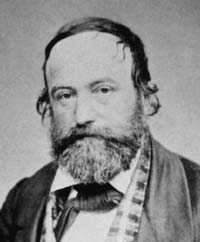
Eugene Bourgeau (Courtesy Saskatchewan Archives Board)
Eugene Bourgeau
(1813-1877) Eugene Bourgeau was the botanist on the Palliser Expedition, his career having begun with his love of flowers in the French Alps where he tended his father's herds. Sir William Hooker, the first Director of Kew Gardens in London, had received many specimens from distant lands through Bourgeau's work. He referred to Eugene Bourgeau as a "prince of botanical collectors," and recommended him to those who were organizing the expedition. Bourgeau was not a disappointment. During his time with the Expedition he collected specimens from eight hundred and nineteen species as well as a great quantity of seeds. John Palliser wrote that, "Little Bourgeau is a brick, his collections seem to me very pretty an the colours as vivid after the specimens are saved as they are in life. He is most indefatigable and always at work." As a horseman however, Palliser described him as, "shocking" and Bourgeau travelled most of the journey across the prairies riding in a Red River cart. Bourgeau accomanied James Hector up the Bow Valley as far as Cascade Mountain. When Bourgeau left the expedition in 1859 to fulfill a previous commitment to do botanical work in London and in the Caucasus in Europe, he had obviously made an impression with Palliser and other members of the expedition. Palliser wrote that Bourgeau was, "always hard at his work in which his whole soul seems engrossed, and no matter what his fatigues or privations may be, his botanical specimens are always his first care. We were very sorry indeed to lose our friend, who was a great favourite with us all. In addition to his acquirements as a botanist, he united the most sociable, jovial disposition, ever ready not only to do his own work, but assist anyone else who asked him." [Additional Information: Spry, Irene M. "The Palliser Expedition". Toronto: Macmillan Co. of Canada Ltd., 1963] [Additional Information: Halworth, Beryl & Jackson, Monica; "Pioneer Naturalists of the Rocky Mountains and Selkirks"]